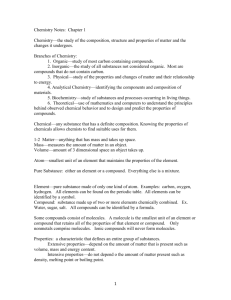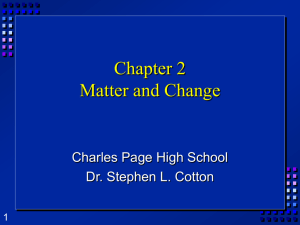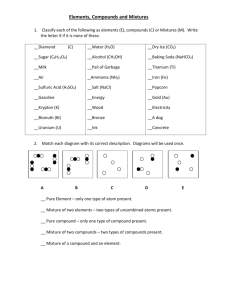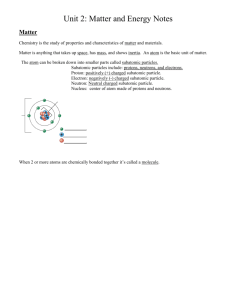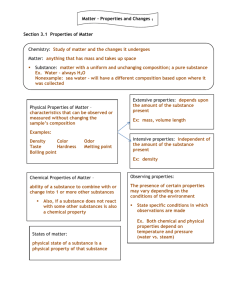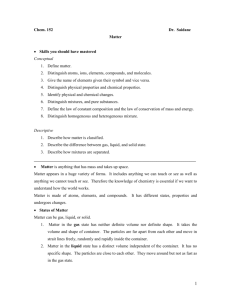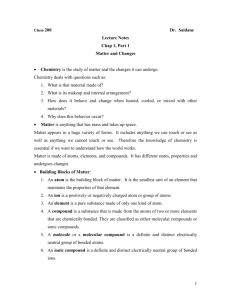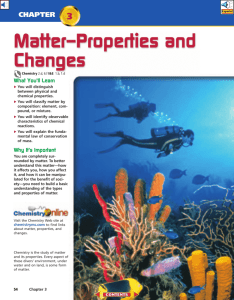Chemistry
advertisement
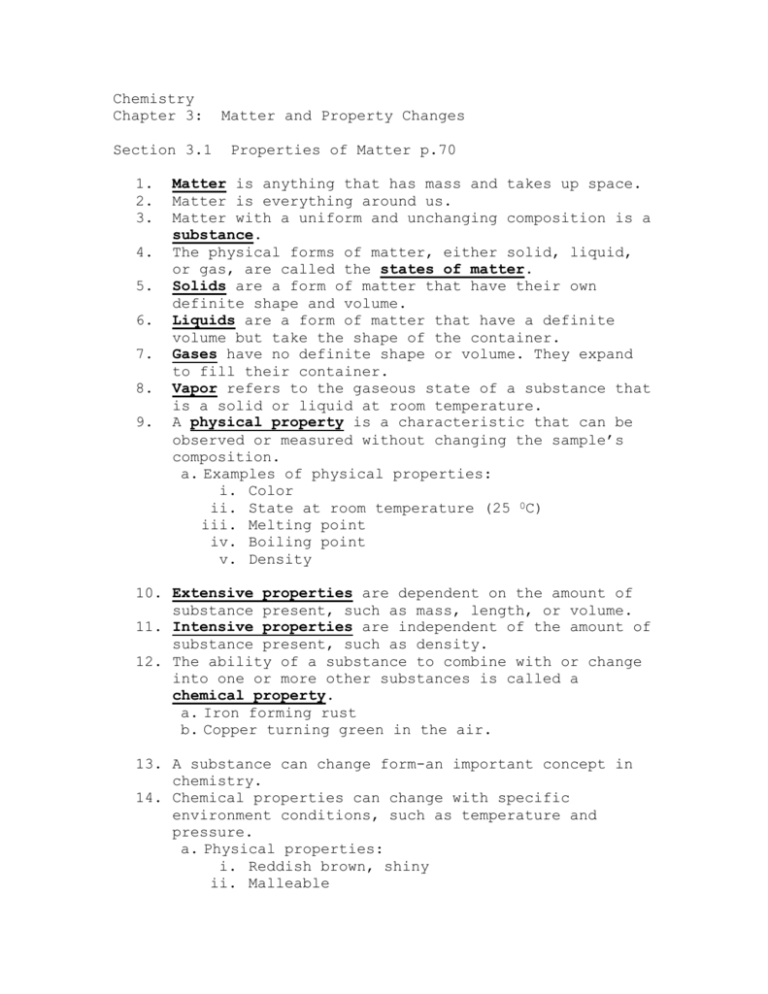
Chemistry Chapter 3: Section 3.1 1. 2. 3. 4. 5. 6. 7. 8. 9. Matter and Property Changes Properties of Matter p.70 Matter is anything that has mass and takes up space. Matter is everything around us. Matter with a uniform and unchanging composition is a substance. The physical forms of matter, either solid, liquid, or gas, are called the states of matter. Solids are a form of matter that have their own definite shape and volume. Liquids are a form of matter that have a definite volume but take the shape of the container. Gases have no definite shape or volume. They expand to fill their container. Vapor refers to the gaseous state of a substance that is a solid or liquid at room temperature. A physical property is a characteristic that can be observed or measured without changing the sample’s composition. a. Examples of physical properties: i. Color ii. State at room temperature (25 0C) iii. Melting point iv. Boiling point v. Density 10. Extensive properties are dependent on the amount of substance present, such as mass, length, or volume. 11. Intensive properties are independent of the amount of substance present, such as density. 12. The ability of a substance to combine with or change into one or more other substances is called a chemical property. a. Iron forming rust b. Copper turning green in the air. 13. A substance can change form-an important concept in chemistry. 14. Chemical properties can change with specific environment conditions, such as temperature and pressure. a. Physical properties: i. Reddish brown, shiny ii. Malleable iii. iv. v. vi. vii. Ductile Good conductor of electricity and heat Density Melting point Boiling point b. chemical properties: i. forms green copper carbonate compound when is contact with moist air. ii. Forms new substances when combined with nitric acid and sulfuric acid. iii. Forms a deep-blue solution when in contact with ammonia. Section 3.2 1. 2. 3. 4. 5. 6. 7. 8. Changes in Matter A change that alters a substance without changing its composition is known as a physical change. A phase change is a transition of matter form one state to another. Boiling, freezing, melting, and condensing all describe phase changes in chemistry. A change that involves one or more substances turning into new substances is called a chemical change. Decomposing, rusting, exploding, burning, or oxidizing are all terms that describes chemical changes. The law of conservation of mass states that mass is neither created nor destroyed in a chemical reaction, it is conserved. The mass of the reactants equals the mass of the products. mass reactants = mass products Section 3.3 Mixtures of Matter 1. 2. 3. 4. p.76 p.80 A mixture is a combination of two or more pure substances in which each pure substance retains its individual chemical properties. A homogenous mixture is a mixture where the composition is constant throughout. Homogeneous mixtures are also called solutions. A heterogeneous mixture is a mixture where the individual substances remain distinct. 5. 6. Types of solution systems: a. Gas-Gas: air in scuba tank is mixture of nitrogen, oxygen, and argon gases. b. Gas-Liquid: oxygen and carbon dioxide are dissolved in seawater. c. Liquid-Gas: moist air exhaled by the scuba diver contains water droplets. d. Liquid-Liquid: when it is raining, fresh water mixes with seawater. e. Solid-Liquid: solid salts are dissolved in seawater. f. Solid-Solid: the air tank is made of an alloy-a mixture of two metals. Filtration is a technique that uses a porous barrier to separate a solid from a liquid in a heterogeneous mixture. 7. Distillation is a separation technique for homogeneous mixtures that is based on the differences in boiling points of substances. 8. Crystallization is a separation technique for homogenous mixtures that results in the formation of pure solid particles from a solution containing the dissolved substance. 9. Sublimation is the process of a solid changing directly to a gas, which can be used to separate mixtures of solids when one sublimates and the other does not. 10. Chromatography is a technique that separates the components of a mixture on the basis of tendency of each to travel across the surface of another material. Section 3.4 Elements and Compounds p.84 1. An element is a pure substance that cannot be separated into simpler substances by physical or chemical means. 2. 92 elements occur naturally on Earth. 3. Each element has a unique name and a one, two, or three-letter symbol. 4. The periodic table organizes the elements into a grid of horizontal rows called periods and vertical columns called groups. 5. A compound is made up of two or more elements combined chemically. 6. Most of the matter in the universe exists as compounds. 7. Table salt, NaCl, and water, H2O, are compounds. 8. Elements can never be separated. 9. Compounds can be broken into components by chemical means. 10. The law of definite proportions states that a compound is always composed of the same elements in the same proportion by mass, no matter how large or small the sample. 11. The relative amounts are expressed as percent by mass, the ratio of the mass of each element to the total mass of the compound expressed as a percentage Percent by mass (%) = mass of element x 100 mass of compound 12. The law of multiple proportions states that when different compounds are formed by a combination of the same elements, different masses of one element combine with the same relative mass of the other element in whole number ratios. a. Examples i. H2O2 and H2O ii. Copper (I) chloride and copper (II) chloride


